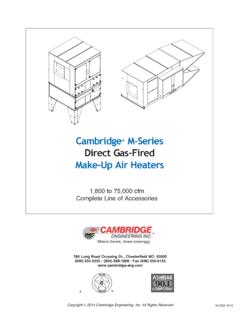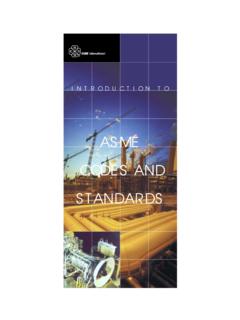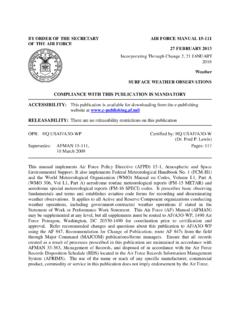Transcription of Recovery Boiler Water Management Guidelines - BLRBAC
1 2. Recovery Boiler Water Management Guidelines (black italicized text = to be developed, green text = completed, blue text = in progress 2015). 1. Clarification/Filtration Systems 2. Makeup Water Systems 3. Feedwater & RB Water Systems Deaerator Systems Feedwater Pump & Piping Systems Design & Operational Considerations Chemical Treatment & Control Considerations Key Maintenance Practices & Protocols SOPs ESOPs Monitoring Inspection/Documentation Feedwater Steam Attemperation Systems Design & Operational Considerations Chemical Treatment & Control Considerations Key Maintenance Practices & Protocols SOPs ESOPs Monitoring Inspection/Documentation Blowdown Heat Recovery Systems Design & Operational Considerations Chemical Treatment & Control Considerations Key Maintenance Practices & Protocols SOPs ESOPs Monitoring Inspection/Documentation 3.
2 4. Recovery Boiler Economizer Systems Design & Operational Considerations Chemical Treatment & Control Considerations Key Maintenance Practices & Protocols SOPs ESOPs Monitoring Inspection/Documentation Drum, Tube & Header Circuitry Design & Operational Considerations Chemical Treatment & Control Considerations Key Maintenance Practices & Protocols SOPs ESOPs Monitoring Inspection/Documentation Chemical Cleaning Introduction & Definitions Cleaning Determination Protocol Chemical Cleaning Key Maintenance Practices & Protocols 5. Condensate Systems Design & Operational Considerations Chemical Treatment & Control Considerations Key Maintenance Practices & Protocols SOPs ESOPs Monitoring Inspection/Documentation 6. Sampling & Testing Protocols 4. Recovery Boiler Water Management Guidelines Fall 2015. Changes: - Changed system sketch from "High Purity Water - Ultra Low Conductivy - Ultra Low Dissolved Oxygen" to "Feedwater Quality Water " to illustrate feedwater pump seal Water .
3 Clarified ORP in the last bullet item, spelling it out as "Oxidation reduction potential (ORP)". - Changed feedwater pH instrumentation from "advisable" to "required". WTSC. checklist is also updated to reflect this change. - Added "and recommended" to the statement "It is a best practice and recommended to reinject cooled feedwater where packing gland systems are utilized". - Added "ESP shutoff valve" to the text that accompanies the illustration of "Attemperation with Feedwater". - Changed wording from "Monitoring cation conductivity will require the installation of a sample cooler and small cation exchange column upstream of the conductivity probe." to "Monitoring cation conductivity requires the installation of a sample cooler and small cation exchange column upstream of the conductivity probe.". - Added the statement to the basic system component design "Heat exchangers (flue gas/feedwater and air/feedwater are optional and not illustrated).
4 ". - Removed the sentence "High pressure sample coolers are required on economizer sampling systems.". - New section added to the document covering the Boiler Water circuit. 5. Feedwater Pump & Piping Systems Feedwater Pump & Piping Systems Design & Operational Considerations System Overview Feedwater pump systems are designed to provide: Stable drum Water level control under all firing conditions A spare pump in the event of main pump failure. Basic System Flow Path The following illustration represents basic deaerator/feedwater circuitry. Recovery Boiler operating systems may vary with respect to component and circuit design. Any variation may impact how the Guidelines are employed. The boundaries for this system are from the deaerator storage tank outlet penetration(s) to the inlet of the economizer. 6. Feedwater Pump & Piping Systems Basic System Component Design A basic feedwater pump system is comprised of: Drop legs or piping runs from one or more deaerator storage tank to a feedwater pump inlet header A feedwater pump suction header (suction side of the pump(s)).
5 Pump suction strainers A feedwater discharge header (discharge side of the pump(s)). Full capacity pump(s) as well as a full capacity backup pump(s). Feedwater pump(s) can be steam- or electric-driven. Preferably the main operating pump would be steam-driven with an electric backup on standby. Where only electric-driven pumps are employed, there should be a secondary source of electrical power supply to the pumps Minimum flow recirculation lines (typically routed back to the deaerator). A pump shaft seal system (either mechanical seals or packing glands with/without seal Water ). Regulating control valve system, an isolation valve, a non-return valve, a drain valve, and a rapid drain valve A high pressure feedwater heat exchanger may be employed for temperature control (not illustrated). Chemical injection quills of proper design and materials of construction A continuous oxygen analyzer (with trend capabilities) is recommended.
6 The sampling system should have sample extraction capabilities on both the suction and discharge side of the feedwater pump(s). Conductivity element with alarm capabilities (located in the droplet below the deaerator storage tank or discharge side of the feedwater pumps. Discharge side is best practice.). Cation conductivity where feedwater is utilized for attemperation (recommended). pH element with alarm capabilities (recommended). Oxidation reduction potential (ORP) measurement (optional). Basic System Control Technology The feedwater flow regulating valve is controlled by a steam drum level control system. The rapid drain valve and feedwater flow stop valve are controlled by the rapid drain system. Chemical Treatment & Control Considerations Water /Steam Purity Impact Assessment Impurities that enter through the feedwater circuit can result in potential damage to the Boiler system circuitry.
7 The source of these impurities can be the deaeration system or the feedwater pump(s). Contamination levels, if significant, can alter Water chemistry and result in corrosion of the circuit metallurgy and/or deposit formation. 7. Feedwater Pump & Piping Systems Key Chemical Control Variables American Society of Mechanical Engineers (ASME) Guidelines should be consulted for a full discussion of chemical control variables, including dissolved oxygen, pH, conductivity, iron, copper, and hardness (ASME Guidelines are contained in the Appendix section). Mills shall maintain emergency standard operating procedures (ESOPs) for reacting to out-of-range feedwater parameters. At a minimum, these shall include oxygen, iron, pH, hardness, silica, and conductivity. When contamination is suspected, operators should always validate their test results and, once validated, follow the ESOPs that are in place to troubleshoot the problem.
8 The validation step is to ensure that the sample conditioning station or sample preparations are not the source of the apparent contamination. Key Maintenance Practices & Protocols System Reliability Impact Assessment Feedwater pumps and pumping systems can produce/experience high flows and can also be a source of contaminant ingress (dissolved solids, oxygen, iron, etc.). Erosion/corrosion of the downstream piping system is the primary concern. Inspection Techniques Inspect pump seal Water systems and review seal Water quality for adequacy (seal Water quality should be equivalent to that of the feedwater). Identify high risk areas in the feedwater piping system (such as bends, elbows, and any injection quill locations) and employ NDE methods to inspect for flow accelerated corrosion. Inspect and routinely calibrate the system O 2 analyzer and visually inspect all associated sample piping and valves.
9 Monitor or periodically inspect for the presence of any sample flow restrictions and/or diversion of sample steams that may impact the accuracy of test results. If raw or mill Water is used on sample cooler/heat exchanger, the heat exchanger should be periodically inspected and cleaned. Inspection Frequency Strainers - There are instances when strainers foul with materials like fiber and resin. The source of these materials can be Water system-related and may have impacted other Water support systems and sample monitoring devices. It is recommended that feedwater pump strainers be inspected in accordance with planned feedwater pump maintenance schedules. In addition, it is advisable to monitor pressure drop across the strainers to ensure that the strainers are not accumulating materials that may restrict feedwater flow. 8. Feedwater Pump & Piping Systems Seal Water Systems - Inspect and review Water quality as mill experience dictates.
10 Feedwater Piping Systems - The mill should develop a protocol that delineates the inspection frequency for flow-assisted corrosion in high risk areas (typically every 3 - 5 years, but can also use condition based methodology). O 2 Analyzers - Units should be inspected and calibrated in accordance with the OEM Guidelines . Associated sample piping systems, valves, and sample coolers should be inspected as mill experience dictates. SOPs - SOP - Feedwater Iron Levels - An SOP shall be in place that states the ASME Guidelines for iron levels in the Boiler feedwater. The SOP should include method of testing, by whom, and how often. (Note: An operator log sheet or data entry system that specifies all of the above may be an acceptable substitute.). Oxygen intrusion and process-related iron ingress can both contribute to high iron levels in the feedwater.



